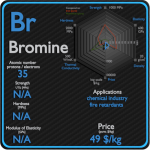This article contains comparison of key thermal and atomic properties of beryllium and magnesium, two comparable chemical elements from the periodic table. It also contains basic descriptions and applications of both elements. Beryllium vs Magnesium.

Beryllium and Magnesium – About Elements


Source: www.luciteria.com
Beryllium and Magnesium – Applications
Beryllium
Berylium can be utilized as alloying agent in production of beryllium-copper, X-ray detection diagnostics, manufacture of computer peripherals, in nuclear reactors as neutron moderators and reflectors. 80% of the beryllium used goes into copper beryllium alloys. The combination of light weight with high strength at extreme temperatures makes beryllium metal and aluminium beryllium alloys ideal for use in high performance aerospace applications such as components of rockets. Transparency to x-radiation makes pure beryllium metal essential in security equipment and high-resolution medical imaging technology, such as mammography to detect breast cancer. Copper beryllium is the hardest and strongest of any copper alloy (UTS up to 1,400 MPa), in the fully heat treated and cold worked condition. It combines high strength with non-magnetic and non-sparking qualities and it is similar in mechanical properties to many high strength alloy steels but, compared to steels, it has better corrosion resistance.
Magnesium
Magnesium is the third-most-commonly-used structural metal, following iron and aluminium.[35] The main applications of magnesium are, in order: aluminium alloys, die-casting (alloyed with zinc), removing sulfur in the production of iron and steel, and the production of titanium in the Kroll process. Magnesium alloys are used in a wide variety of structural and nonstructural applications. Structural applications include automotive, industrial, materials-handling, commercial, and aerospace equipment. Magnesium alloys are used for parts that operate at high speeds and thus must be light weight to minimize inertial forces. Commercial applications include hand-held tools, laptops, luggage, and ladders, automobiles (e.g., steering wheels and columns, seat frames, transmission cases). Magnox (alloy), whose name is an abbreviation for “magnesium non-oxidizing”, is 99% magnesium and 1% aluminum, and is used in the cladding of fuel rods in magnox nuclear power reactors.
Beryllium and Magnesium – Comparison in Table
| Element | Beryllium | Magnesium |
| Density | 1.848 g/cm3 | 1.738 g/cm3 |
| Ultimate Tensile Strength | 345 MPa | 200 MPa |
| Yield Strength | N/A | N/A |
| Young’s Modulus of Elasticity | 287 GPa | 45 GPa |
| Mohs Scale | 5.5 | 2.5 |
| Brinell Hardness | 600 MPa | 260 MPa |
| Vickers Hardness | 1670 MPa | N/A |
| Melting Point | 1278 °C | 649 °C |
| Boiling Point | 2469 °C | 1090 °C |
| Thermal Conductivity | 200 W/mK | 156 W/mK |
| Thermal Expansion Coefficient | 11.3 µm/mK | 24.8 µm/mK |
| Specific Heat | 1.82 J/g K | 1.02 J/g K |
| Heat of Fusion | 12.2 kJ/mol | 8.954 kJ/mol |
| Heat of Vaporization | 292.4 kJ/mol | 127.4 kJ/mol |













